In Remembrance
Posted: 1 November 2010 21:53
I recently took two trips to Hastings Cemetery to locate the graves of service personnel who lost their lives through enemy action or accident. Having found many WW2 graves in one small plot, the stories behind those laid to rest here are fascinating, if inevitably tragic.
The plot in question is Division 'O' Section 'A' of the cemetery; the majority of WW2 service personnel lie within this area, although a handful lie scattered across other areas.
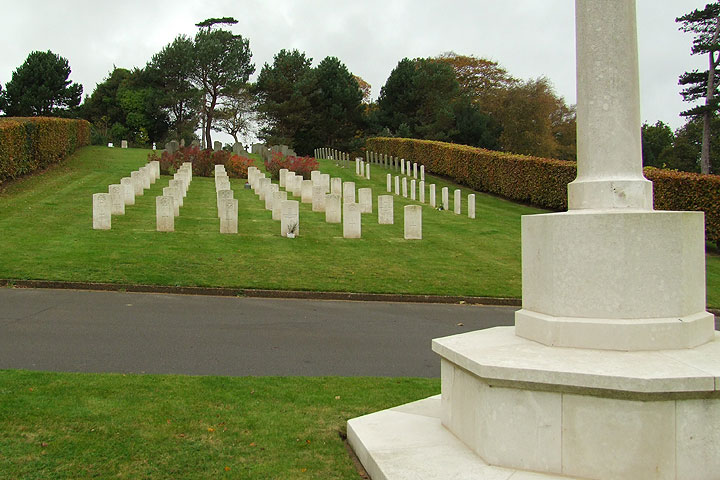
Hastings Cemetery is the most interesting I have visited in East Sussex to date; within the dedicated WW2 area lie not only British soldiers, sailors and airmen, but also some civilian air raid victims and seven German servicemen.
Comparatively few Germans now rest outside of the German military cemetery at Cannock Chase in Staffordshire which was inaugurated in 1967. German personnel were originally buried in the local designated military cemetery closest to where they crashed or were washed ashore. After the war most were relocated to Cannock Chase or else repatriated by their family, but for some reason, a few remained in their original graves.
Canadian personnel were mostly interred in Brookwood Cemetery in Surrey; although there are numerous WW1 burials, I've not seen any WW2 Canadian graves at Hastings.
A few selected headstones are shown below.
The Plaza Cinema bomb, 30 September 1940
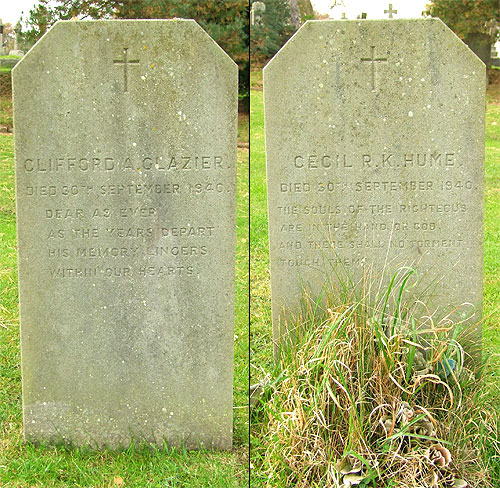
The most tragic air raid on Hastings in 1940 happened on 30 September, when a high explosive bomb struck the facade of the Plaza Cinema.
Eight people were killed outright, the eventual toll being 14 dead, 12 seriously injured and 23 lightly wounded.
Two of the victims are buried in the civilian section of plot OA; Cecil Hume and Clifford Glazier, a 14-year-old boy.
The war diary of the infantry brigade stationed in the area simply states:
"1 HE bomb in Hastings. Killed 9 including RAF corporal and 1 Home Guard."
The Home Guard in question was QMS A.H. Southey, who was killed along with his wife.
Their funeral took place 4 days later with members of Headquarters Company of 23rd Battalion, Sussex Home Guard, acting as bearers. Although they lie in Hastings Cemetery, I was unable to locate their grave.
Another member of HQ Company was killed by bombing on 6 November; however, Mr. G. Lee is not included in the Commonwealth War Graves Commission's database.
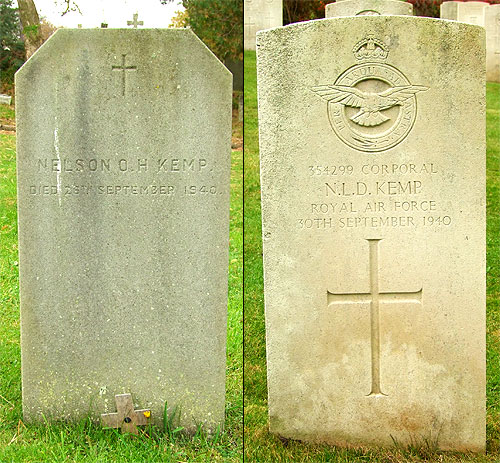
A further tragedy of the Plaza Cinema bomb was that of the RAF Corporal mentioned above, Norman Kemp, and his brother, Nelson.
Nelson had been killed in an air raid on Hastings only four days previously on 26 September.
Brother Norman was in Hastings that fateful day in connection with funeral arrangements, when he too fell victim to German bombing.
More information is in Hastings & St Leonards in the Front Line published in 1945 by the Hastings & St Leonards Observer, but for full details of air raids on the town, see Nathan Dylan Goodwin's outstanding book, Hastings at War 1939-45 (2005).
Luftwaffe Aircrew

I mentioned above that seven German personnel lie in Hastings Cemetery; Eberhard Weyergang and Gustav Nelson were Luftwaffe aircrew who were killed when their Messerschmitt Me110 was shot down on 25 September 1940.
The war diary again:
"ME110 crashed in flames. 1 occupant killed, other died on way to hospital."
They are the first Germans I've mentioned in terms of remembrance; this is purely because so few still lie in local cemeteries, but the issue of reconciliation with a former enemy even after 70 years is contentious. Some veterans feel they can forgive, but others (particularly those berieved, or who witnessed the horror of war and atrocities committed), can never forgive and never forget. I feel that it's for the individual to decide their position.
Minefield and other accidents
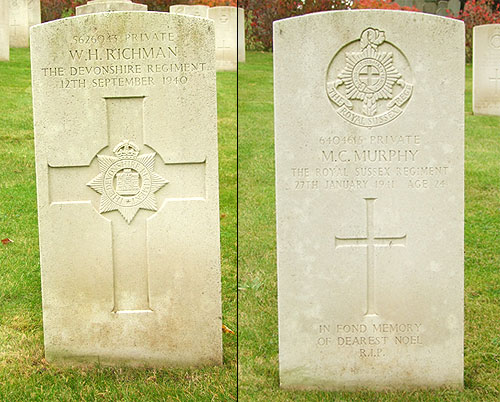
Not all casualties were the result of enemy action and combat though. As I've written in previous Remembrance pieces, accidents were all too frequent; Privates Richman and Murphy were victims of dangers inherent in wartime.
Private William Richman of the Devonshire Regiment was a beach mine victim at Fairlight on 12 September 1940. It may be that Richman's accident revealed the presence of the minefield to the Germans; the documents indicate that the very next day, six HE bombs were dropped in the same area, blowing up a large number of mines.
September 1940 was a bad month for fatal accidents in East Sussex minefields; one fatality at Rye on the 16th, two more at Newhaven on the 20th with yet more deaths as four men were laying mines at Cuckmere Haven on the 22nd.
However, the minefields at Fairlight were still to claim another victim from the Devons; 11 days after Richman's death, Capt. Ray Thorne was killed on 23 September and is buried in Morte Hoe Cemetery in Devon.
Minefields were not the only cause of fatal accidents, however. On 27 January 1941 the war diary of 70 Royal Sussex Regt. state: "Pte Murphy died as a result of gun wound. Accidental." Such accidents were inevitable; quite often a soldier seemingly forgetting his weapon was loaded, "larking around", or a nervous sentry. By tragic coincidence, the following day another 70 Royal Sussex soldier died; Private Gabbitas fell from the cliffs at Fairlight. His death, like that of Murphy, was recorded as accidental. Gabbitas is the only WW2 serviceman buried at St Andrew's churchyard in Fairlight.
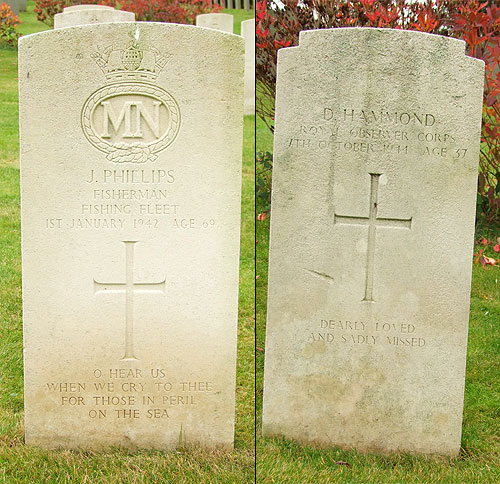
Hastings Cemetery still holds some mysteries. Although my research is focussed primarily on military matters, two further cases are of particular interest to me: James Phillips of the Merchant Navy (fishing fleet) and D. Hammond of the Royal Observer Corps.
At this time I have no documentary evidence regarding either of them; I have seen references to fishing boats being shot up by German aircraft and it would be no surprise if I were to find a ROC post being attacked as well, but at this time, I just don't know.
One interesting piece of information from the CWGC database is that Phillips had served with the Royal Sussex Regiment in the Great War.
However, there are many documents yet to be consulted and I'm hopeful I can find a few more answers.
- Pete

Email:
Blog Latest

Bishopstone reveals its pillbox secrets
18 October 2021

Pillbox or Observation Post?
10 June 2020

Uncovering the hidden secrets of a pillbox
8 June 2019

Review of 2018
31 December 2018

Wartime Christmas in East Sussex (2)
24 December 2018
Jargon-buster
War diary
A record of events kept by all units from the point of mobilisation. A diary's contents vary enormously from unit to unit; some give detailed entries by the hour on a daily basis while others merely summarise events on a weekly/monthly basis.
This site is copyright © Peter Hibbs 2006 - 2024. All rights reserved.
Hibbs, Peter In Remembrance (2024) Available at: http://www.pillbox.org.uk/blog/216670/ Accessed: 26 April 2024
The information on this website is intended solely to describe the ongoing research activity of The Defence of East Sussex Project; it is not comprehensive or properly presented. It is therefore NOT suitable as a basis for producing derivative works or surveys!